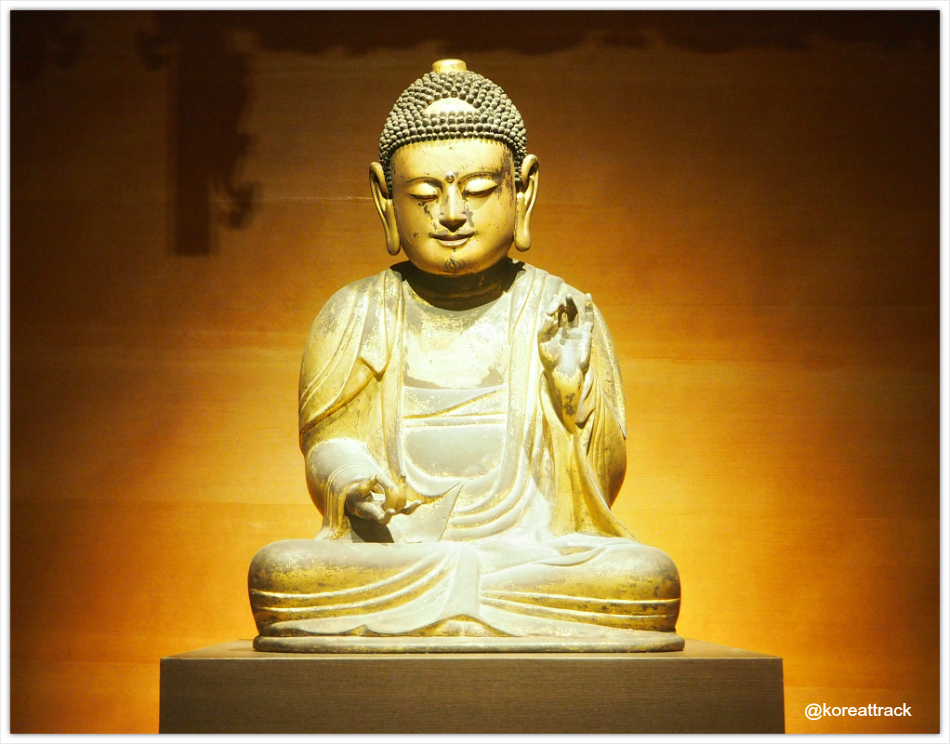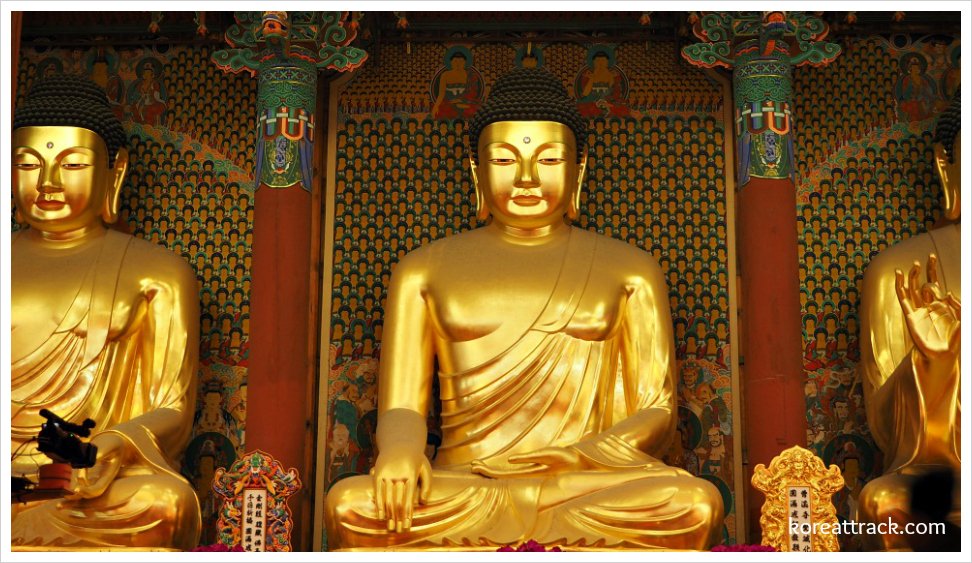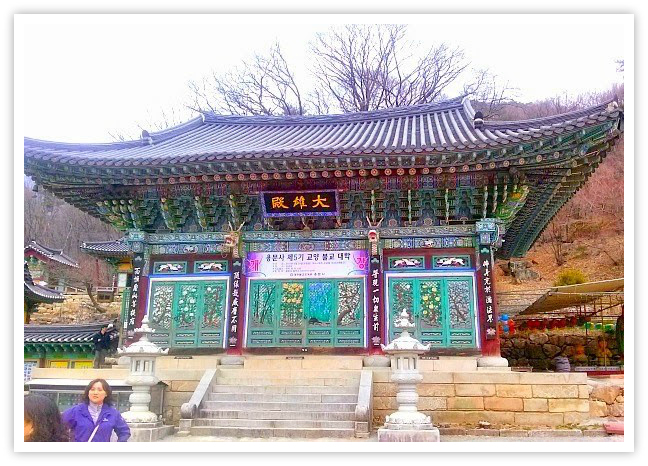Timeless Mireuksa Temple
In Iksan City
 Mireuksa Temple in Iksan
Mireuksa Temple in IksanMireuksa Temple In Iksan
Mireuksa Temple is one of the most ancient and revered Buddhist temples in South Korea. Nestled in Iksan, North Jeolla Province, this stunning temple has a rich history dating back over a thousand years.
The temple is renowned for its magnificent architecture, intricate designs, and remarkable relics that reflect the country's cultural and spiritual heritage.
From the towering pagodas to the ornate gates, every corner of the temple exudes an air of tranquility and beauty that will captivate visitors.
If you're a history buff, a spiritual seeker, or just someone looking for a peaceful escape from city life, Mireuksa Temple is one of your destinations in Iksan.
In this article, we will examine the temple's fascinating history, unique features, and attractions and how to get there from Seoul.
Historical Background
 This is a frontal view of one of the three pagodas at Mireuksa Temple.
This is a frontal view of one of the three pagodas at Mireuksa Temple.Mireuksa-ji Temple Site is a historical site in Iksan, Jeollabuk-do, South Korea. This fascinating temple's history dates back to the Baekje Kingdom (18 B.C. – 660 A.D.).
It was first constructed in 602 A.D. by King Mu of Baekje (r. 600-641 A.D.). The temple site is south of Mt. Mireuksan (429.6 m), formerly known as Mt. Yonghwasan.
The temple was built after a pond was filled over at the request of King Mu's wife, the Queen.
Records indicate that Mireuksa Temple was a Baekje Kingdom national temple built to help strengthen the nation's power.
The temple was designed with three parallel courtyards, each with a pagoda and a temple shrine hall. So, Mireuksa Temple would have had three temple shrine halls and three pagodas.
 Ruins of Mireuksa Temple in Iksan
Ruins of Mireuksa Temple in IksanThe temple's construction started in the latter half of the Baekje Kingdom, also known as the Sabi Period (538-660 A.D.).
It continued to be expanded during Later Silla (668-935 A.D.), through the Goryeo Dynasty (918-1392), and up until the Joseon Dynasty (1392-1910).
During this time, the temple became a significant religious and cultural site, attracting many visitors from all over the country.
However, the temple was eventually destroyed by the invading Japanese during the Imjin War (1592-1598) in 1592. It would remain in disrepair until the early part of the 20th century.
Despite the temple's destruction, many of its structures and artifacts were preserved, and it remains an essential historical site in South Korea.
Today, visitors can explore the temple's remains, including the foundation stones of the pagodas and shrine halls.
The temple site is surrounded by beautiful natural scenery, and visitors can enjoy a peaceful and serene atmosphere while learning about the temple's rich history.
 Rebuilt pagodas at Mireuksa Temple in Iksan
Rebuilt pagodas at Mireuksa Temple in IksanFeatures of Mireuksaji Stone Pagoda
Mireuksaji Stone Pagoda
The Mireuksaji Stone Pagoda is one of the largest and oldest Korean pagodas and is a testament to ancient architectural mastery.
The pagoda was initially constructed of wood during the Baekje period (18 BC—660 AD). It was destroyed during the Mongol invasions in the 13th century and later reconstructed using stone.
The temple complex that once featured the nine-story wooden pagoda at its center was crafted by the skilled Baekje artisan Abiji.
Unfortunately, the wooden pagoda was destroyed during the Mongol invasions in the 13th century.
Designated as South Korean Historic Site No. 150
Due to its historical significance, the Mireuksa temple complex has been designated as South Korean Historic Site No. 150. It is a popular site for tourists exploring Korea's ancient history.
The Mireuksa temple complex has been partially restored and now houses a museum.
Visitors can explore the temple's history and learn more about the ancient architectural techniques used to construct the pagoda.
 A Mireuksa Temple's pagoda and its reflection
A Mireuksa Temple's pagoda and its reflectionThe second restoration of the Mireuksa pagoda was completed in 2018.
The project aimed to preserve the pagoda's historical significance and ensure that it continues to stand as a testament to ancient architectural mastery for generations.
Mireuksa Temple Layout and Arrangement
According to historical records, the layout and arrangement of the Mireuksa Temple in Iksan were genuinely unique and impressive.
The temple was situated on a flat plain and had a distinctive arrangement of three pagodas aligned in a straight line from east to west, each with a hall to its north.
The central pagoda was made of wood, a rare material for building pagodas at that time, and it had nine stories, making it the tallest structure in the temple complex.
The other two pagodas were made of stone and had seven and five stories, respectively.
 Stone foundations at Mireuksa Temple in Iksan City
Stone foundations at Mireuksa Temple in Iksan CityIn addition to the pagodas, excavations have also revealed the sites of a large central hall and a middle gate.
The main hall was located north of the central pagoda, which was a spacious and elegant building with a curved roof and multiple eaves.
The middle gate was located to the south of the central pagoda and was a simple yet elegant structure that served as the entrance to the temple complex.
The overall layout and arrangement of Mireuksa Temple in Iksan were carefully planned and designed to create a harmonious and balanced environment that would inspire a sense of awe and reverence in visitors.
The temple's unique combination of wooden and stone pagodas, spacious main hall, and elegant middle gate made it one of the most impressive and vital Buddhist temples of its time.
Attractions in the Area
Mireuksaji National Museum: Located at 362 Mireuksaji-ro, Geumma-myeon, this museum provides insights into the temple's history and Baekje culture. It's open from Tuesday to Sunday.
Hiking Trails: Explore the mountain behind the temple for scenic views and a refreshing hike.
Historical Significance: Mireuksa is one of the most important historical sites in South Korea, offering a serene and peaceful experience.
Flagpole Supports (Mireuksaji Dangganjiju): These are another intriguing feature of the temple site.
If you're keen on understanding Korea's classical heritage, visiting Mireuksa is a must!
Getting to Iksan City from Seoul
You can quickly get to Mireuksa Temple in Iksan using a private or rented vehicle. However, the following guide will be helpful if you go there by public transportation.
By Train
From Seoul Station, take a KTX or Mugunghwa train to Iksan Station. The journey takes approximately 2-3 hours. From Iksan Station, Mireuksa Temple is accessible by taxi or bus.
By Bus
Buses depart from Seoul Express Bus Terminal or Dong Seoul Bus Terminal to Iksan Intercity Bus Terminal. From there, take a taxi or bus (#41, #60, #60-1, or #60-3) to Mireuksa Temple.
Sources
Mireuksa - Wikipedia. https://en.wikipedia.org/wiki/Mireuksa
- Home
- Temples in South Korea
- Mireuksa Temple In Iksan
Get Exciting Activities
Book one of our exciting activities today to experience the thrill of a lifetime! Take advantage of this opportunity and secure your spot in advance.
Hotel Map Guide
Find your affordable, accessible, and comfortable hotel in Seoul at Agoda.Com. See the hotel map below...
Hotel Booking Guide
Find affordable and amazing hotels on Agoda.com using the search box below. Book now to enjoy great discounts and save!







New! Comments
What do you think about this page? Leave me a comment in the box below.